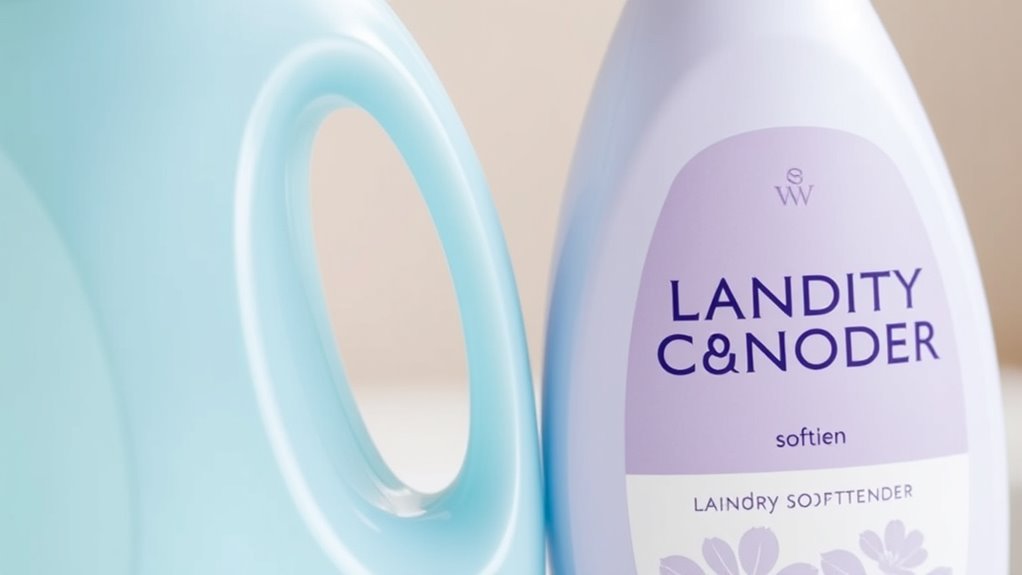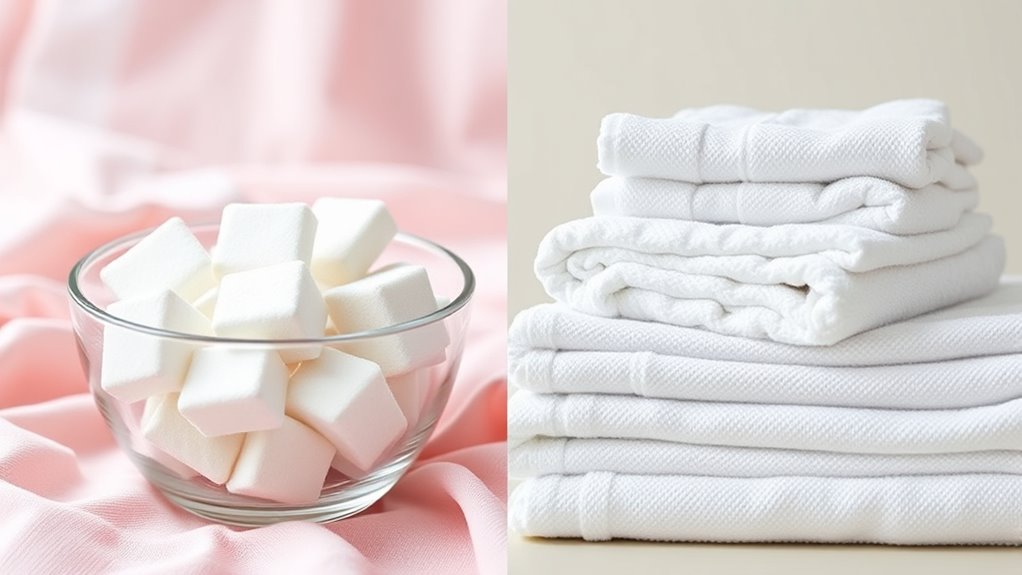Use fabric softener when you want your clothes to feel softer, smell fresher, and have less static, especially with everyday fabrics. Choose fabric conditioners to protect delicate fabrics, reduce wear, and extend clothing lifespan. Softeners focus on comfort and scent, while conditioners prioritize fabric care and longevity. Knowing when to use each helps enhance your laundry results—keep exploring to discover more about how to best care for your clothes and fabrics.
Key Takeaways
- Use fabric softeners to make clothes feel softer, reduce static, and add long-lasting fragrances.
- Opt for fabric conditioners to protect delicate fabrics and extend clothing lifespan through gentle care.
- Choose eco-friendly options when concerned about environmental impact and skin sensitivity.
- Softeners primarily focus on scent and softness, while conditioners prioritize fabric integrity and longevity.
- Apply softeners during final rinse for fragrance and softness; use conditioners regularly for overall fabric care.

When it comes to maintaining your laundry, many people wonder whether fabric softener or conditioner is the better choice. It’s an important decision because each option offers unique benefits, and your choice can impact how your clothes feel, smell, and even how eco-friendly your laundry routine is. Fabric softeners are designed to make clothes feel softer, reduce static cling, and often leave behind a fresh scent. However, some softeners contain chemicals that aren’t eco-friendly, prompting many to seek eco friendly options that are safer for both the environment and sensitive skin. These eco-friendly options often use plant-based ingredients, avoid artificial fragrances, and minimize the use of harsh chemicals. If you’re concerned about scent retention, softeners can be particularly effective because they deposit fragrance compounds onto fibers during the wash cycle. This means your clothes stay smelling fresh longer, which is especially appreciated if you enjoy wearing freshly laundered clothes throughout the week. Many softeners also contain ingredients that help prevent stiffness and make ironing easier, giving your laundry a more polished look.
On the other hand, fabric conditioners function a bit differently. They often work by coating fabrics with a thin layer that reduces friction, which can result in less wear and tear over time. Conditioners excel at maintaining the integrity of delicate fabrics and are sometimes marketed as being more natural or eco-friendly, especially if they use biodegradable ingredients. If you’re looking for a product that’s gentle on your clothes and the environment, considering eco-friendly conditioners is a smart move. These conditioners can also promote scent retention, though perhaps not as intensely as traditional softeners. They tend to focus more on fabric care and longevity rather than just scent. Additionally, choosing conditioners with biodegradable ingredients can help reduce environmental impact and support sustainability efforts. They often are infused with natural essential oils, offering a subtle, long-lasting fragrance without the use of synthetic chemicals.
Frequently Asked Questions
Can Fabric Softener Be Used on Towels?
You can use fabric softener on towels, but it might affect towel softness and fabric absorbency over time. Softeners coat fibers, making towels feel smoother, but they can also reduce their ability to absorb water. If you want fluffy, highly absorbent towels, it’s better to skip fabric softener occasionally. For softer towels, use it sparingly; for maximum absorbency, consider air drying or using alternatives like vinegar.
Is It Safe to Mix Fabric Softener With Laundry Detergent?
You might wonder if it’s safe to mix fabric softener with laundry detergent. Mixing these can cause unwanted chemical reactions that might reduce cleaning effectiveness or damage fabrics. Additionally, combining them increases allergy risks, especially for sensitive skin. To stay safe, always follow product instructions and avoid mixing unless specified. Using each separately guarantees your laundry stays fresh and safe without risking chemical reactions or allergic reactions.
How Often Should I Use Fabric Conditioner?
Oh, the classic dilemma—how often should you indulge your laundry with fabric softener? Well, if you want your clothes to feel like cloud nine, follow your laundry softening schedule, typically once every few washes. Overdoing it can dull fabrics or cause buildup, so use fabric conditioner sparingly—usually every 3-4 washes. Keep it simple, and your clothes will thank you with softness and freshness.
Are There Fabrics That Shouldn’t Be Treated With Softener?
You should avoid using fabric softener on delicate fabrics like silk or lace, as it can harm their fibers. Waterproof materials, such as raincoats or outdoor gear, also shouldn’t be treated with softener, because it can impair their water resistance. Instead, use gentle detergents or specific treatments designed for these materials. Always check care labels to verify you’re not compromising the fabric’s integrity or functionality.
Can Conditioner Replace Fabric Softener Completely?
In this modern era, it’s clear that a conditioner can’t fully replace fabric softener. While conditioner may enhance fabric softness temporarily, it lacks the specific chemical composition designed for laundry, which helps reduce static and smooth fibers effectively. Using conditioner alone could compromise your laundry’s quality over time, making it less soft and more prone to damage. For ideal results, stick to fabric softener for maintaining the desired fabric softness.
Conclusion
Think of fabric softener as the gentle breeze that caresses your clothes, adding comfort and freshness. Conditioner, meanwhile, is like a protective shield, strengthening fibers and preserving quality. Knowing when to use each is like choosing the right breeze or shield for each moment—softener for daily comfort, conditioner for long-lasting durability. By selecting wisely, you guarantee your wardrobe remains a symbol of care, comfort, and resilience, ready to face each new day with confidence.










